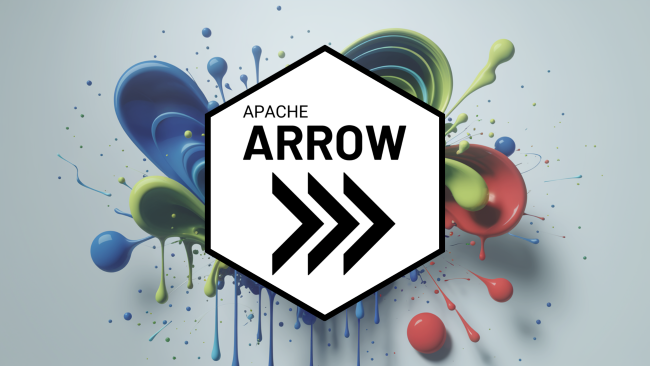Apache Arrow Explained


Published on
Ever wonder why your data pipeline spends so much time converting formats than it does actually processing data? You're not alone. In the world of modern data engineering, we've built incredible tools for processing massive datasets, but we're still losing tremendous amounts of compute cycles to something surprisingly mundane: moving data between systems.
Enter Apache Arrow—the "universal translator" for analytics workloads that is revolutionizing how we think about in-memory data processing. If you've ever cursed at serialization overhead or wondered why your polyglot data stack feels like the UN without translators, this one's for you.
The Problems Apache Arrow Solves
The Data Format Tower of Babel
Let's talk about the elephant in the room: the serialization/de-serialization tax. And everyone hates taxes, right? Picture your typical data pipeline:
- REST API returns JSON
- Parse JSON into Python objects
- Convert to Pandas DataFrame
- Write to SQL database
- Export to Parquet for analytics
- Load into Spark for processing
Each hop in this journey involves converting data from one format to another. It's like playing telephone with bytes—expensive telephone where each translation costs CPU cycles and memory allocations. There have been some studies that show that data serialization can account for up to 80% of the total processing time in analytics pipelines. That's right: you could be spending more time packing and unpacking data than actually analyzing it.
Memory Layout Mismatches
Here's where the eternal struggle between row-based and columnar storage comes to a head. Your transactional database thinks in rows because that's how OLTP workloads operate—grab a record, update it, move on. But your analytics engine? It wants columns because aggregating a million sales figures is faster when they're sitting next to each other in memory.
The cost of transposing between these formats isn't trivial. Every time you move from row-store to column-store (or vice versa), you're essentially scrambling your data's memory layout. Cache locality goes out the window, and your CPU starts playing musical chairs with memory addresses.
Then there's the language interoperability nightmare. Python has NumPy arrays, Java has ByteBuffers, R has data frames, and JavaScript has... well, JavaScript has its own special way of handling things. Each language ecosystem has independently evolved its own way of representing tabular data, and they're about as compatible as oil and water. The result? We spend enormous engineering effort building bridges between these islands.
The Zero-Copy Dream
The current reality is sobering: to share data between processes or languages, we copy it. Process A serializes data, writes it somewhere (network, disk, shared memory), Process B reads it, de-serializes it, and finally gets to work. Even "efficient" formats like Protocol Buffers or MessagePack still require this dance.
The dream? Share memory directly without copies. Imagine if Python and Java could look at the exact same bytes in memory and both understand them perfectly, no translation required. This isn't just a nice-to-have optimization—real-world systems have seen 10-100x performance improvements when they eliminate these copies.
Apache Arrow Architecture
Core Concept: Columnar Memory Format
Here's the key insight that makes Arrow special: it's a specification, not an implementation. Arrow doesn't care whether you're using Python, Java, C++, or Rust. It defines a language-agnostic memory layout that everyone agrees to use. Think of it as a peace treaty in the data format wars—"We'll all agree on how the bytes are laid out, and everyone can bring their own implementation."
The format is columnar, meaning data for each column is stored contiguously in memory. But unlike file formats like Parquet, Arrow is designed for in-memory processing. There's no compression, no encoding tricks—just raw data laid out for maximum CPU efficiency.
The Building Blocks
Arrow's type system covers everything you'd expect in a modern data processing framework:
Primitive Types: Your standard integers, floats, booleans, and timestamps. These are stored in simple arrays with optional null bitmaps for missing values.
Variable-Length Types: Strings and binary data use a clever offset-based approach. The actual data lives in one buffer, while another buffer stores offsets indicating where each value starts.
Complex Types: Lists, structs, and unions allow for nested data structures. Yes, you can have a column of arrays of structs containing maps. Arrow handles it.
The beauty is in the metadata. Every Arrow array carries its schema—type information, field names, and other metadata travel with the data. It's self-describing, which means you never have to guess what you're looking at.
The Ecosystem Components
Arrow isn't just a format; it's an entire ecosystem:
Arrow Flight: Built on gRPC, Flight is a protocol for high-performance data transport. Instead of serializing to JSON or CSV for your REST API, Flight lets you stream Arrow data directly. It's like upgrading from a garden hose to a fire hose.
Gandiva: A expression compiler that generates vectorized code for query execution. Write your filter expression once, and Gandiva compiles it to SIMD instructions that process multiple values simultaneously.
Parquet Integration: Arrow and Parquet are best friends. Parquet handles efficient storage on disk; Arrow handles efficient processing in memory. The conversion between them is highly optimized and often zero-copy.
Real-World Use Cases
ETL Pipeline Optimization
Consider a typical ETL pipeline that ingests CSV files, performs transformations, and outputs to a data warehouse. Without Arrow, each stage converts data to its preferred format. With Arrow, the entire pipeline operates on the same in-memory format.
A financial services company I'm familiar with reported a 70% reduction in processing time after switching their ETL pipeline to Arrow. The magic wasn't in faster algorithms—it was in eliminating format conversions entirely.
Cross-Language Analytics
Here's a common scenario: your data scientists work in Python, your backend team prefers Java, and your frontend developers need JavaScript for visualizations. Traditionally, you'd serialize data at each boundary, probably to JSON.
With Arrow, you can share memory directly between these languages. Python can manipulate a DataFrame, Java can run business logic on it, and JavaScript can visualize it—all without a single serialization step. The data literally never moves; only pointers are passed around.
Real-Time Stream Processing
IoT and sensor data present unique challenges. You're dealing with high-velocity data that needs to be batched, windowed, and aggregated in near real-time. Arrow's columnar format is perfect for these operations. Calculating the average temperature across a million sensors? That's a single SIMD instruction when your data is in Arrow format.
Distributed Computing
Apache Spark 3.0's adoption of Arrow for Python UDFs was a game-changer. Previously, data was pickled and un-pickled at the Python boundary—a notorious bottleneck. With Arrow, Spark can share data with Python processes at native speeds. The result? 10x faster Pandas integration and vectorized UDF execution that actually keeps up with Scala performance.
Products Powered by Arrow
Dremio: The Data Lakehouse Platform
Dremio went all-in on Arrow, and it shows. They use Arrow Flight for client connections, store reflections (materialized views) in Arrow format, and even expose Arrow-based APIs for custom processing. The performance benefits are substantial—queries that previously required multiple format conversions now execute entirely in Arrow's columnar format.
The Pandas Revolution
Pandas 2.0's adoption of Arrow for string types wasn't just an implementation detail—it was a fundamental shift. String operations that were previously Python's Achilles heel now execute at C++ speeds. Memory usage dropped by up to 70% for string-heavy datasets.
The New Guard
Polars: This DataFrame library was built on Arrow from day one. The result? It regularly outperforms Pandas by 5-10x on standard benchmarks.
DuckDB: Treats Arrow as a first-class citizen, allowing direct queries on Arrow tables without conversion.
Snowflake: Returns query results in Arrow format, eliminating client-side parsing overhead.
Google BigQuery: Exports data directly to Arrow, making it trivial to pull terabyte-scale datasets into local analytics tools.
When to Use Apache Arrow
Perfect Fit Scenarios
Arrow shines when you're dealing with:
- Analytics and OLAP workloads with columnar operations
- Multi-language data science pipelines where zero-copy matters
- High-throughput data transport between services
- In-memory computing platforms that need CPU-efficient formats
Consider Alternatives When
Arrow might be overkill for:
- Small-scale OLTP applications where row-based access patterns dominate
- Document-oriented databases with highly nested, irregular schemas
- Simple REST APIs returning small JSON payloads (though Arrow Flight might surprise you)
- Legacy systems where integration complexity outweighs performance benefits
Get Started with Apache Arrow
Want to dip your toes in the Arrow waters? Here are some quick wins:
- Replace CSV/JSON in data pipelines: Start with one pipeline that's spending too much time on serialization. Swap in Arrow and measure the difference.
- Use Arrow-backed Pandas DataFrames: Just add
dtype_backend="pyarrow"when reading data. You'll get better performance and memory usage for free. - Implement Arrow Flight for data services: If you're building a new data service, consider Flight instead of REST. Your future self will thank you.
Here's a simple example to get you started:
import pyarrow as pa
import pyarrow.compute as pc
import pandas as pd
# Create an Arrow table
data = {
'product': ['widget', 'gadget', 'doohickey', 'thingamajig'],
'sales': [100, 150, 75, 200],
'profit_margin': [0.2, 0.3, 0.15, 0.25]
}
table = pa.table(data)
# Compute without converting to Pandas
total_sales = pc.sum(table['sales'])
avg_margin = pc.mean(table['profit_margin'])
# Zero-copy conversion to Pandas when needed
df = table.to_pandas(zero_copy_only=True)The Future is Columnar
We're witnessing a convergence in the data ecosystem. Major players are standardizing on Arrow not because it's trendy, but because it solves real problems. The inefficiencies we've accepted as "just the cost of doing business" are becoming unnecessary technical debt.
The trajectory is clear: Arrow is becoming the default for analytical workloads. Just as JSON became the de facto standard for web APIs, Arrow is becoming the standard for in-memory analytics. The difference is that Arrow was designed for this purpose from the ground up.
Start with one pipeline. Pick the one that's causing you the most pain—the one where you've already tried every optimization trick in the book. Replace the serialization boundaries with Arrow, measure the difference, and prepare to be surprised. Sometimes the best optimization isn't a clever algorithm or a bigger cluster. Sometimes it's just agreeing on a standard.
After all, in a world where compute is cheap but data movement is expensive, the winning move is not to move data at all. Arrow makes that possible, and that's why you needed to know about it.
Quick Reference: Arrow vs. Others
| Aspect | Arrow | Protocol Buffers | Parquet | JSON |
|---|---|---|---|---|
| Orientation | Columnar | Row-based | Columnar | Document |
| Use Case | In-memory analytics | RPC/Serialization | Storage | Web APIs |
| Zero-Copy | Yes | No | No | No |
| Compression | No (by design) | Yes | Yes | No |
| Schema Evolution | Limited | Excellent | Good | None |
| Language Support | 12+ languages | 10+ languages | 8+ languages | Universal |
Code Example: Zero-Copy Between Processes
# Process A: Write Arrow data to shared memory
import pyarrow as pa
import pyarrow.plasma as plasma
client = plasma.connect("/tmp/plasma")
data = pa.table({'col1': range(1000000)})
object_id = plasma.ObjectID.from_random()
client.put(data, object_id)
# Process B: Read without copying
client = plasma.connect("/tmp/plasma")
[data] = client.get([object_id], zero_copy=True)
# data is now available without any serialization!Remember: Arrow isn't about replacing your entire stack. It's about eliminating the friction between the tools you already use. And in the world of data engineering, less friction means more time for actual engineering.